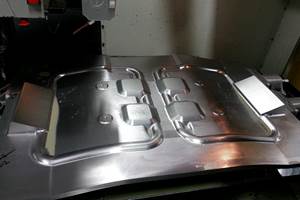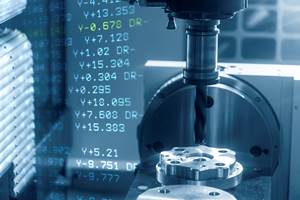How to Measure Special Diameters
More complicated checks sometimes require more versatile measurement systems with long ranges.
Share





Sometimes we are faced with making critical diameter checks on parts that do not present themselves in a straightforward fashion. Usually these checks are on the inside of some type of bearing that can be almost any size. Or they might be on a giant transmission housing large enough to walk through and include measuring the diameter of an internal surface behind a shoulder, where the entry diameter is smaller than the diameter being measured. Or they might require measuring a ring groove in a bore, the pitch diameter of an internal thread, the effective diameter of a barrel roller bearing or the included angle of a tapered bore.
Measuring these types of diameters requires that the gage have some unique characteristics. Depending on the tolerances, having the simple capability to make multiple diameter checks with a very versatile system may be the most critical requirement. Or you may have a situation where tight tolerances demand the high repeatability of a comparative gage, long-range jaw retraction to allow entry into the part, and the ability to set the depth of the contact to make the measurement at the proper point.
Many people immediately think of using a shallow-bore gage for this type of application. As we have discussed in the past, this type of gage rests on the face of the part and measures the inside diameter at a certain depth. These are fairly accurate comparative gages that allow the depth of the contact to be set to a specific location. However, these gages are typically limited by the amount of travel in the indicating device used for the readout. As simple fixed-diameter gages, they work well, but they do not meet the need for long range to get behind a shoulder or to have the contact measure the groove diameter they are generally set to measure. Nor do they have any versatility to check other dimensions.
Two types of measuring devices do meet the needs of these types of applications: universal caliper inner diameter/outer diameter gages, and long-range slides coupled with high-resolution, long-range digital indicators.
The universal caliper ID/OD gage is basically just as it sounds: a long digital scale with a readout, but also with two moving slides upon which interchangeable jaws/contacts are mounted. Universal is truly the right term, as this type of measuring instrument allows for the various jaw sets to be mounted on either the top or bottom of the display. No more trying to read upside-down measuring results. The other benefit of this type of arrangement is its versatility. The greatest benefit of any digital caliper is the versatility to measure multiple features. With these universal ID/OD gages, that benefit is compounded, as the increased range allows for expanded capacity. Both jaws can be set anywhere within the range of the tool, allowing it to be well balanced at the point of manufacture.
These long-range universal measuring systems serve a valuable role in the general inspection of large parts that have loose to medium tolerances. However, all caliper gages are subject to some operator influence related to gaging pressure, skill and scale accuracy over the long measuring range.
To take the process up to the next level requires a move to a comparative version of the system using a long-range digital indicator as part of the measuring frame. This has the benefit of actually referencing the measurement based on an external precision reference master—the accuracy built into the digital indicator's precision scale. The combination of the long-range, high-resolution digital indicator and a soundly designed mechanical frame can provide a universal ID (or OD) gage that has endless applications for those hard-to-reach inside measurement applications.
Of course, the contacts must be designed to handle the depth and gaging pressures, but the beauty of this type of gage is that its long range offers the ability to measure any number of depths within that range. So besides measuring a depth at a particular location, it can measure two diameters at different depths, thus becoming a taper gage measuring the included angle of the tapered bore.
Related Content
2 Secondary Coordinate Systems You Should Know
Coordinate systems tell a CNC machine where to position the cutting tool during the program’s execution for any purpose that requires the cutting tool to move.
Read More4 Tips for Staying Profitable in the Face of Change
After more than 40 years in business, this shop has learned how to adapt to stay profitable.
Read MoreTips for Designing CNC Programs That Help Operators
The way a G-code program is formatted directly affects the productivity of the CNC people who use them. Design CNC programs that make CNC setup people and operators’ jobs easier.
Read MoreHow to Determine the Currently Active Work Offset Number
Determining the currently active work offset number is practical when the program zero point is changing between workpieces in a production run.
Read MoreRead Next
Last Chance! 2025 Top Shops Benchmarking Survey Still Open Through April 30
Don’t miss out! 91ÊÓƵÍøÕ¾ÎÛ's Top Shops Benchmarking Survey is still open — but not for long. This is your last chance to a receive free, customized benchmarking report that includes actionable feedback across several shopfloor and business metrics.
Read MoreAMRs Are Moving Into Manufacturing: 4 Considerations for Implementation
AMRs can provide a flexible, easy-to-use automation platform so long as manufacturers choose a suitable task and prepare their facilities.
Read MoreMachine Shop MBA
Making Chips and 91ÊÓƵÍøÕ¾ÎÛ are teaming up for a new podcast series called Machine Shop MBA—designed to help manufacturers measure their success against the industry’s best. Through the lens of the Top Shops benchmarking program, the series explores the KPIs that set high-performing shops apart, from machine utilization and first-pass yield to employee engagement and revenue per employee.
Read More






















